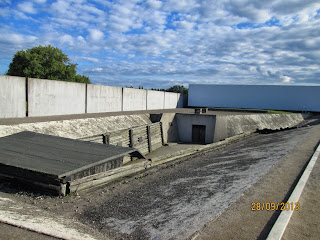We were headed for Dascha, another of Luke's recommendations; as the
lady wasn't prompt in opening up and time was of the essence we found
breakfast down the road in this kooky venue, all exposed brickwork and second-hand
furniture. Mercifully this morning was wasp-free and wifi-enabled!
(Kooky breakfast)
From breakfast we headed to a flea market in the north of
the city. We arrived promptly at 10:30 but the park was already packed, the
stands rammed full of potential customers. The majority of stands featured
standard content; scarves, records, vintage clothes, jewellery; one particular
stand stood out, it sold watches and jewellery but was manned by an eccentric
gentleman in a top-hat. Sometimes display really is everything…
(Flea Market)
Potsdam
From the hectic flea market we boarded The Ring in the opposite direction, towards
Potsdam. Like Oranienburg, Potsdam is about 1 hour's travel from Berlin city centre. Potsdam is a town of great consequence. Kaiser Wilhelm built a country house, Schloss Cecilienhof.
Hitler claimed to be his heir by marching through the city. Churchill and the
allies met here to decide the division of Germany at the Potsdam Conference, and the Red Army also had a presence here.
Schloss Cecilienhof
I headed for Schloss Cecilienhof, boarding a local bus and praying I'd be reunited with my ally before we boarded our flight home. I was merrily minding my own business when I was ambushed by a troop of some 20 exhausted English tourists and their tour guide, quite possibly a Miranda Hart voice-double on the weekends, promising they 'will never need to run again'.
(Miranda tour-guide)
The house itself was like a little slice of England, built by Kaiser Wilhelm, grandson of Queen Victoria for his wife Cecilia. It was a gloriously sunny afternoon in a park full of peace, and flowers, gold leaf and lovely boats. I really would recommend a visit in the afternoon in good weather. Entry to each museum building charged separately, main house 6€ - I just walked round the gardens, for free.
Park Sans Souci
After a brief nerve-wracking moment my friend and I were reunited and we headed for Park Sans Souci, Frederick the Great's pleasure palace and gardens, created in the 18th century. Comparisons could reasonably be made with Versailles or Hampton Court, the gardens were all fountains and landscape gardening. We saw gods and goddesses, muses and even soldiers dressed up in full-Regency livery. We enjoyed our little moment of luxury, it seemed a world away from yesterday's experiences. I wouldn't have paid to go into any of the buildings, but maybe that's personal taste, I've never been that bothered by Regency history. We took some beautiful photos in the low-lying sun and met a charming, but shy young man (he was maybe 3?) at the railway station on the way to the airport.
Being in Berlin has, as always, been a pleasure. I've really enjoyed getting under the skin of this city, the veritable queen of reinvention. Needless to say I'll be back soon.




















